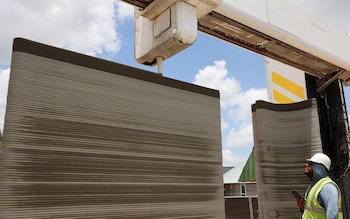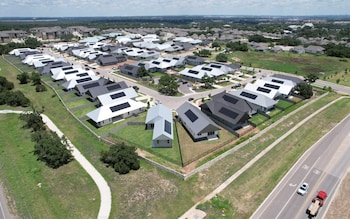In Texas, a towering 45ft robot is putting the finishing touches on what is thought to be the world’s largest 3D-printed neighbourhood.
Icon, the developer behind the project, is printing off its 100th house at Wolf Ranch in Georgetown this summer, less than two years after kicking off the project.
It takes around three weeks for work on each home to be completed.
Concrete powder, water, sand and other additives are mixed together and pumped into a 4.75 tonne printer called Vulcan.
The mixture is then piped like icing through a nozzle along a pre-programmed path, layer-by-layer. The resulting appearance of the walls is likened to corduroy.

Printing off homes in this way is faster, cheaper, requires fewer workers and minimises waste, according to the company.
Senior project manager Conner Jenkins said: “It brings a lot of efficiency to the trade market. Where there were maybe five different crews coming in to build a wall system, we now have one crew and one robot delivering that scope. [There’s] the same advantages for the supply chain system.
“We hope that as we [consolidate] these different systems, we can bring down volatility in the housing market.”
Printed homes at Wolf Ranch are priced from around $450,000 (£353,510) to roughly $600,000. They range from 1,500 to 2,000 sq ft and consist of either three or four bedrooms in a single-storey floorplan.

Residents Lawrence Nourzad and Angela Hontas, who bought a printed home at the ranch earlier this summer, compared their new house to a “fortress”.
Mr Nourzad said the walls are solid enough to “go head-on with maybe an F2, F3 tornado and be pretty resilient”. They were praised for keeping the interior cool in the Texas heat, but criticised for causing connectivity problems.
Mr Nourzad said: “These are really strong, thick walls. That’s what provides a lot of value for us as homeowners. But signal doesn’t transfer through these walls very well.”
The walls are designed to be resistant to water, mould, termites and extreme weather.
While the walls are printed, the foundation and metal roof are installed through traditional construction methods.
For its next project, Icon has been contracted by Nasa to built shelters and landing pads that are suitable for the Moon’s surface.
Disclaimer: The copyright of this article belongs to the original author. Reposting this article is solely for the purpose of information dissemination and does not constitute any investment advice. If there is any infringement, please contact us immediately. We will make corrections or deletions as necessary. Thank you.



